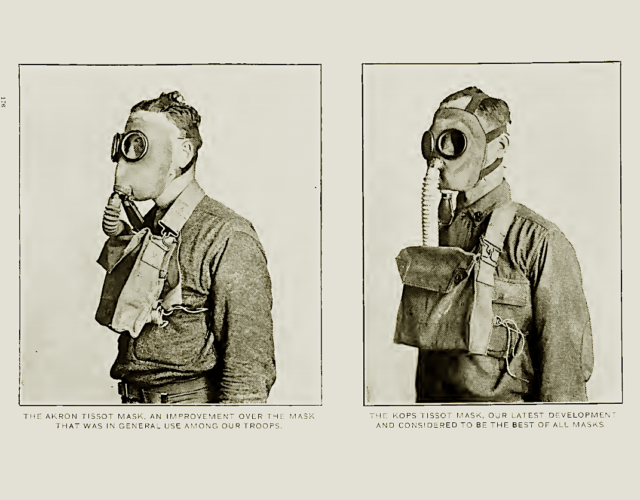In the summer of 1921 a chemical demonstration sent a battalion of 200 “stalwart Philadelphia policemen” running away weeping. Philadelphia’s “huskiest men,” a reporter wrote, experienced firsthand the effectiveness of tear gas. The weapon had proven useful on the battlefields of World War I in dispersing waves of attackers, stinging opponents’ eyes to spoil their aim, and otherwise rendering soldiers inoperative. Once the war was over, the companies that made the gas searched for new markets for their product. They found America’s police forces ready, if tearful, customers.
German scientists first created the tear-inducing chemical chloroacetophenone in the late 19th century. Despite its name, tear gas is not a gas but a micropulverized powder that, when dispersed in the air, causes uncontrollable tears, irritated breathing, and escalating pain. Early in the 20th century French police experimented with tear gas in capturing criminals, but for the most part the substance lay dormant until called up for combat in the Great War. Both Allied and German forces weaponized tear gas and used it intermittently before switching to deadlier chlorine- and mustard-gas attacks in the spring of 1915. When the American Expeditionary Forces entered the war in 1917, they also adopted experimental use of both tear gas and lethal chemical agents.
After the war was over, thousands of decommissioned soldiers returned home looking for work, but there weren’t enough jobs in an economy shifting from wartime to peacetime production. The result was a severe spike in labor agitation, including many riots aimed at African Americans, whom white workers resented for their wartime employment gains. Between 1919 and 1921 alone, at least 29 violent strikes and major race riots in the United States required federal military intervention to restore civil order. Law enforcement clamored for a crowd-control tool that did not involve shooting civilians. Tear gas, army veterans realized, could address two problems at once: its use could safely disperse rioters—without the use of violence—and its continued production might create more jobs.
U.S. domestic industries had rushed to manufacture stocks of chemical weapons during the war, including vast production of tear-gas munitions. After the armistice the broadly expanded U.S. chemical industry needed new markets for its former wartime products. Several veterans from the Chemical Warfare Division (CWD), the successor to the army unit that had developed the weapons, began peacetime careers in the chemical industry. They set their sites on domestic police forces as a market ripe for their chemical crowd-control products. One army lieutenant wondered how the “forces of law and order,” which had benefited from wartime improvements to wireless radio and airplanes, had not received “one of the most effective and harmless weapons the great war produced?”
By 1921 the CWD oversaw a series of tear-gas tests and sales to police departments around the country. That January, while struggling with the rise of organized crime, the Chicago police department announced its plans to incorporate tear-gas “bombs” to apprehend criminals. On Long Island, New York City’s Riot Battalion conducted a set of tests with tear-gas “grenades.” One headline declared “Policemen Weep in Face of Riot Gas: Nightsticks Are Discarded for Kerchiefs When Men in Test Are Blinded by Tears.” Philadelphia’s tear-gas test not only sent its stalwart policemen in “hasty and wet-eyed retreat” but also affected some unlucky passersby. Reportedly, a small dog that wandered into the test and a “rotund” spectator, who “unintentionally” sat on and exploded a grenade, both fled the scene whimpering.
The chemical’s effectiveness for riot control was clear. Police forces across the nation soon adopted tear gas as a standard part of their arsenals. In only a few years tear gas had transitioned from a military to a civilian technology. By the end of 1923 more than 600 cities were equipped with tear gas, and many had effectively used it against civilians. From that point forward, domestic police forces needed no approval or assistance by federal troops to use tear gas during domestic disorders.
Tear gas is not the only technology to have transitioned from a wartime weapon to a domestic police tool, as evidenced by the nationwide “crisis of police militarization.” Other such technologies include assault rifles, Humvees and other armored personnel carriers, Special Weapons and Tactics (SWAT) teams, and, now, cybertools for communications surveillance. But tear gas is unique in that it worked more effectively as a police tool than a military tool. Today tear gas remains an essential nonlethal tool for U.S. police forces, even though countless examples of its misuse exist. But it represented a de-escalation of force at the time it was introduced. And as Americans today increasingly exercise their constitutional right to public protest, they can march mindful that tear gas, and not bullets, will likely fill streets first if things escalate into violence.




